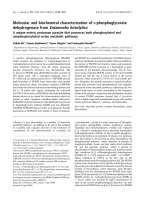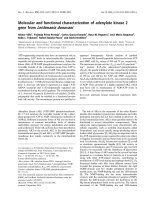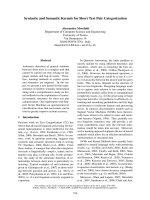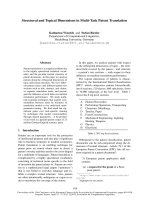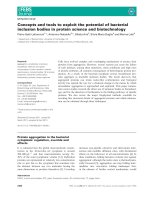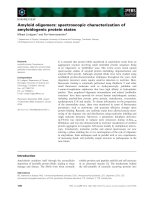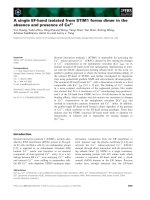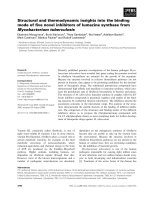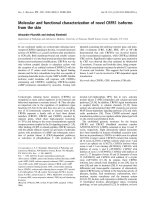Báo cáo khoa học: Molecular and genetic characterization of osmosensing and signal transduction in the nematode Caenorhabditis elegans docx
Bạn đang xem bản rút gọn của tài liệu. Xem và tải ngay bản đầy đủ của tài liệu tại đây (469.36 KB, 8 trang )
MINIREVIEW
Molecular and genetic characterization of osmosensing
and signal transduction in the nematode Caenorhabditis
elegans
Keith P. Choe and Kevin Strange
Departments of Anesthesiology, Pharmacology and Molecular Physiology and Biophysics, Vanderbilt University, Nashville, TN, USA
Introduction
Regulation of intracellular and extracellular solute and
water balance is a fundamental requirement for meta-
zoans. The volume of animal cells is regulated by accu-
mulation and loss of inorganic ions, primarily Na
+
,
K
+
and Cl
–
, and specialized organic solutes termed
organic osmolytes [1,2]. The effector mechanisms that
mediate volume regulatory changes in the intracellular
levels of these solutes are generally well-defined [1].
However, little is known about how animal cells detect
volume changes and transduce those signals into regu-
latory responses.
Extracellular solute and water balance in animals is
maintained by behavioral responses and by the func-
tion of the kidney and kidney-like organs, and extra-
renal organs, such as the insect hindgut, fish and
crustacean gills and the mammalian intestine. As with
cell volume perturbations, the molecular mechanisms
by which animals detect extracellular osmotic and
ionic disturbances are not fully defined. In addition,
little is known about how the activities of various
osmoregulatory solute and water transport pathways
are coordinately regulated during osmotic challenges.
The nematode Caenorhabditis elegans provides
numerous experimental advantages for defining the
Keywords
mechanosensing osmoregulation; osmotic
stress; organic osmolytes; Ste20 kinases;
TRP channels; WNK kinases
Correspondence
K. Strange, Vanderbilt University Medical
Center, T-4202 Medical Center North,
Nashville, TN 37232-2520, USA
Fax: +1 615 343 3916
E-mail:
(Received 2 July 2007, accepted 30 August
2007)
doi:10.1111/j.1742-4658.2007.06098.x
Osmotic homeostasis is a fundamental requirement for life. In general, the
effector mechanisms that mediate cellular and extracellular osmoregulation
in animals are reasonably well defined. However, at the molecular level,
little is known about how animals detect osmotic and ionic perturbations
and transduce them into regulatory responses. The nematode Caenorhabd-
itis elegans provides numerous powerful experimental advantages for defin-
ing the genes and integrated gene networks that underlie basic biological
processes. These advantages include a fully sequenced and well-annotated
genome, forward and reverse genetic and molecular tractability, and a rela-
tively simple anatomy. C. elegans normally inhabits soil environments
where it is exposed to repeated osmotic stress. In the laboratory, nema-
todes readily acclimate to and recover from extremes of hypertonicity. We
review recent progress in defining the molecular mechanisms that underlie
osmosensing and associated signal transduction in C. elegans. Some of
these mechanisms are now known to be highly conserved. Therefore,
studies of osmosensing in nematodes have provided, and will undoubtedly
continue to provide, new insights into similar processes in more complex
organisms including mammals.
Abbreviations
dsRNA, double stranded RNA; GCK-3, germinal center kinase-3; GFP, green fluorescent protein; OSR1, oxidative-responsive 1; PASK,
proline-alanine-rich Ste20-related kinase (also known as SPAK); RNAi, RNA interference; Ste20, sterile-20; TRP, transient receptor potential;
TRPV, TRP-vanilloid; WNK, with-no-lysine (K).
5782 FEBS Journal 274 (2007) 5782–5789 ª 2007 The Authors Journal compilation ª 2007 FEBS
molecular bases of physiological processes including
osmoregulation [3,4]. Worms have a short life cycle (2–
3 days at 25 °C), produce large numbers of offspring by
sexual reproduction and can be cultured easily and inex-
pensively in the laboratory. Sexual reproduction occurs
by self-fertilization in hermaphrodites or by mating with
males. Self-fertilization allows homozygous animals to
breed true and greatly facilitates the isolation and main-
tenance of mutant strains whereas mating with males
allows mutations to be moved between strains. The
reproductive and laboratory culture characteristics of
C. elegans make it an exceptionally powerful model sys-
tem for forward genetic analysis. Mutagenesis and
genetic screening allows the unbiased identification of
genes underlying a biological process of interest, allows
genes to be ordered into pathways, and can provide
important and novel mechanistic insights into the
molecular structure and function of proteins.
In addition to forward genetic tractability, C. ele-
gans also has a fully sequenced and well-annotated
genome. The genomic sequence and virtually all other
biological data on this organism are assembled in read-
ily accessible public databases (e.g. WormBase; http://
www.wormbase.org). Numerous reagents including
mutant worm strains and cosmid and YAC clones
spanning the genome are freely available through pub-
lic resources. Creation of transgenic worms is relatively
easy, inexpensive and rapid, requiring little more than
injection of transgenes into the animal’s gonad or
bombardment with DNA-coated microparticles. C. ele-
gans gene expression can be specifically and potently
targeted for knockdown using RNA interference
(RNAi), either at the single worm level by injection of
double stranded RNA (dsRNA), or at the population
level by feeding worms dsRNA-producing bacteria.
Libraries of dsRNA feeding bacteria are now available
that allow for over 90% of the genome to be screened
for a particular phenotype. Finally, C. elegans is a
highly differentiated animal but is comprised of
< 1000 somatic cells. This relatively simple anatomy
greatly facilitates the study of biological processes and
has made it possible to trace the lineage of every adult
cell beginning with the first cell division.
C. elegans inhabits surface soil and decaying organic
matter that undergoes periodic desiccation. Under lab-
oratory conditions, worms can readily survive and
acclimate to extreme osmotic stress [5,6]. In addition,
these animals have well developed sensory mechanisms
that allow them to detect and avoid hypertonic envi-
ronments [7]. Our goal in this minireview is to summa-
rize what is currently known about the molecular
mechanisms of osmotic stress resistance, osmosensing
and signal transduction in C. elegans.
Osmoregulatory organs in C. elegans
C. elegans has simple ‘kidney’ that is comprised of
three cells, the excretory cell, the duct cell and the pore
cell [8]. Destruction of any of these cells by laser abla-
tion causes the animal to swell with fluid and die [9].
The excretory cell is a large, H-shaped cell that
sends out processes both anteriorly and posteriorly
from the cell body. A fluid-filled excretory canal is sur-
rounded by the cell cytoplasm. The basal pole of the
cell faces either the pseudocoel or hypodermis whereas
the apical membrane faces the excretory canal lumen.
An excretory duct connects the excretory canal to the
outside surface of the worm. The duct is formed from
cuticle that is continuous with the animal’s exoskele-
ton. A duct cell surrounds the upper two-thirds of the
duct and a pore cell surrounds the lower third.
The excretory cell is a single-cell ‘epithelium’ that
secretes solutes and water into the excretory canal.
Duct cells may also play an important role in solute
and water transport. The apical surface area of duct
cells is greatly amplified by extensive invaginations and
the cytoplasm is filled with mitochondria, suggesting
that it may be involved in solute transport, possibly
selective solute reabsorption [8].
The worm ‘skin’ or hypodermis is an epithelium that
underlies a thick cuticle composed of collagens. Gap
junctions connect the excretory cell to the hypodermis,
suggesting an interaction between the two cell types
important for whole animal osmoregulation. In addi-
tion, several studies have suggested a role for the
hypodermis in osmoregulation. For example, a recent
study suggests that fibroblast growth factor signaling
in the hypodermis regulates whole animal fluid balance
[10].
The intestine of adult C. elegans is comprised of 20
epithelial cells that function in digestion and nutrient
absorption. In addition, the intestine is in direct con-
tact with the external environment and thus could
readily mediate osmoregulatory exchanges of solutes
and water. Recent studies support the notion that the
intestine plays an important role in whole animal
osmoregulation [11,12].
Behavioral avoidance of osmotic stress
Nematodes sense the external environment in part
through a pair of openings in the cuticle on their head
termed amphids. Eight neurons associate directly with
each amphid pore and contact the external environ-
ment via dendrites that terminate in sensory cilia.
Another four sensory neurons have dendrites that
associate with a support cell termed the amphid sheath
K. P. Choe and K. Strange Osmosensing and signaling in C. elegans
FEBS Journal 274 (2007) 5782–5789 ª 2007 The Authors Journal compilation ª 2007 FEBS 5783
cell. Axons extend from the cell bodies of the amphid
neurons to the central nervous system where they
make synaptic contacts with other neurons. Laser abla-
tion studies have demonstrated that the amphid neu-
rons function in thermosensation, chemosensation and
mechanosensation [13].
C. elegans is attracted to low concentrations of salts,
sugars and other chemicals. However, at high concen-
trations, worms initiate an avoidance response to these
substances. Culotti and Russell [7] concluded that the
repellent effect of these solutes is due to hypertonicity
rather than to the solutes themselves. Using forward
genetic analysis, Culotti and Russell [7] identified osm
mutants that were osmotic avoidance defective.
osm-9 mutants are defective in their ability to detect
not only hypertonic media, but also mechanical pertur-
bation (nose touch), volatile repellents and chemical
attractants [14,15]. The OSM-9 protein is a 937-amino
acid member of the transient receptor potential (TRP)
family of cation channels. TRP channels are divided
into TRPC, TRPV, TRPM, TRPML, TRPP, TRPN
and TRPA subfamilies. All TRP channels are com-
prised of six predicted transmembrane domains and
intracellular N- and C-termini. Functional TRP chan-
nels are formed from homomeric or heteromeric asso-
ciation of four TRP subunits. TRP channels function
in diverse physiological processes, including sensory
transduction, epithelial transport of Ca
2+
and Mg
2+
,
Ca
2+
signaling and modulation of membrane potential
[16,17].
OSM-9 was the first TRP-vanilloid (TRPV) channel
to be identified at the molecular level. Green fluores-
cent protein (GFP) reporter studies demonstrated that
OSM-9 localizes in the superficial sensory cilia of
amphid neurons where it could directly detect envi-
ronmental hypertonicity, mechanical force, and chemi-
cal attractants and repellents [14]. Unfortunately,
OSM-9 has not yet been successfully expressed in a
heterologous system where it can be functionally
characterized. However, consistent with the role of
osm-9 in osmosensation and mechanosensation, mam-
malian TRPV4 has been shown to be activated by
hypotonic stress when expressed heterologously [18].
TRPV4 is expressed in circumventricular organs of
the mammalian central nervous system where it
appears to play a role in detecting plasma osmolality
and regulating the secretion of the systemic osmoregu-
latory hormone vasopressin [19]. Interestingly, even
though OSM-9 and TRPV4 only share 26% amino
acid identity, TRPV4 rescues the defects in osmotic
avoidance and nose touch behaviors when it is
expressed in the amphid neurons of osm-9 mutant
worms [20]. Mutations in TRPV4 that affect its
functioning as an ion channel eliminate or reduce its
ability to rescue, indicating that cation flux through
the channel is likely the proximal signal that mediates
osmosensing and mechanosensing [20]. The mechanism
by which OSM-9 and TRPV4 detect hypertonic media
and nose touch are unclear. However, it is possible
that the channels are regulated via mechanical forces
transmitted directly through the lipid bilayer and ⁄ or
cytoskeletal attachments.
ocr-2, odr-3 and osm-10 are also expressed in amp-
hid sensory neurons and are essential for the osmotic
avoidance behavior. OCR-2 is another TRPV family
member and it colocalizes with OSM-9 in amphid
neuron sensory cilia [21]. Interestingly, both proteins
must be present for either of them to localize prop-
erly, suggesting that OSM-9 and OCR-2 form a het-
eromeric channel and ⁄ or function in a multiprotein
signaling complex [21]. odr-3 encodes a Ga protein
and null mutations in this gene prevent detection of
nose touch, volatile repellents and hypertonicity [22].
These phenotypes are very similar to those of osm-9
mutants, suggesting that ODR-3 may function with
the channel to regulate the response to external stim-
uli. osm-10 encodes a novel cytosolic protein that is
essential for detection of hypertonicity, but not nose
touch or volatile repellents [23], suggesting that it
may be involved in discriminating osmotic from
other stimuli that activate OSM-9 and ⁄ or OCR-2.
Although more work is needed to understand if and
how OSM-9, OCR-2, ODR-3 and OSM-10 function
together to mediate osmotic avoidance, studies on
these proteins illustrate the power of forward genetic
analysis in C. elegans as a means to identify rapidly
and in an unbiased manner genes involved in osmo-
sensing.
Protein damage triggers organic
osmolyte accumulation
Measurements of internal osmolality have not been
made on C. elegans because of the animal’s small
size. However, other nematodes that have been stud-
ied are hyper-osmoconformers that maintain an inter-
nal osmolality slightly higher than that of the
environment [24]. This is not surprising considering
that nematodes lack a rigid skeleton. Instead, internal
turgor or hydrostatic pressure inflates a flexible cuticle
and gives the animal rigidity that is necessary for
locomotion.
The soil and decaying organic environments of
C. elegans are osmotically unstable and the animal
undoubtedly experiences periods of desiccation and
rehydration in its native habitat. In the laboratory,
Osmosensing and signaling in C. elegans K. P. Choe and K. Strange
5784 FEBS Journal 274 (2007) 5782–5789 ª 2007 The Authors Journal compilation ª 2007 FEBS
worms readily acclimate to extreme hypertonic stress
[5,6]. When exposed to hypertonic media, C. elegans
rapidly loses water and up to 50% of its body volume.
If the shrinkage is severe, worms become paralyzed
due to loss of turgor pressure [5,25] (Fig. 1A). Worms
exposed to nonlethal hypertonic stress recover their
volume within a few hours by yet to be characterized
mechanisms. During long-term exposure to hypertonic-
ity, C. elegans synthesizes and accumulates large quan-
tities of the compatible organic osmolyte glycerol
(Fig. 1B) [5,11].
Signaling pathways that regulate organic osmolyte
accumulation in animal cells are poorly defined. To
begin identifying the signaling mechanisms that regu-
late glycerol synthesis, we performed a genome-wide
RNA interference screen for genes that regulate
osmosensitive gene expression [11]. Expression of the
gene gpdh-1, encoding glycerol-3-phosphate dehydro-
genase-1, an enzyme that catalyzes a rate-limiting
step of glycerol synthesis, increases dramatically in
C. elegans following exposure to hypertonic stress [5]
(Fig. 1B). To assess gpdh-1 expression in vivo,we
generated a strain of worms that expresses GFP dri-
ven by the gene’s promoter. GFP expression in this
strain is virtually undetectable unless the worms are
exposed to hypertonic media. Using this reporter
strain and a library of RNAi feeding bacteria [26],
we screened for gene knockdowns that activate
gpdh-1. This screen identified 122 genes whose
knockdown induced gpdh-1 expression in the absence
of hypertonic stress. These genes are termed regula-
tors of glycerol-3-phosphate-dehydrogenase (rgpd)
expression [11].
rgpd gene functions fell into six defined categories;
extracellular matrix, signaling, metabolism, protein
trafficking, transcriptional regulation and protein
homeostasis, as well as a group of genes with unas-
signed functions. Interestingly, genes predicted to func-
tion in cellular protein homeostasis are the largest
class of rgpd genes (54 out of 122 total rgpd genes).
These include genes that encode proteins required for
RNA processing, protein synthesis, protein folding and
protein degradation. Knockdown of these genes is
expected to increase intracellular levels of damaged
and denatured proteins. Damaged proteins in turn act
as a signal to activate glycerol accumulation (Fig. 2).
Glycerol functions to stabilize protein structure and its
accumulation would allow cells to lower intracellular
ionic strength, which can disrupt protein synthesis and
folding [11].
Interestingly, protein damage caused by other stres-
sors, such as heat shock and oxidative stress, do not
activate gpdh-1 expression, demonstrating that osmotic
stress causes a form of protein damage that selectively
induces glycerol accumulation [11]. Osmotic stress has
been shown previously to disrupt new protein synthesis
[27,28], which likely results in the accumulation of
incomplete and aberrantly folded polypeptides in the
cytoplasm. The majority of the protein homeostasis
genes identified in our RNAi screen function in RNA
processing, protein synthesis and cotranslational pro-
tein folding [11]. These observations are consistent
with a model in which gpdh-1 expression is specifically
activated by osmotically induced disruption of new
protein synthesis and cotranslational folding rather
than by denaturation of existing proteins (Fig. 2). Such
a mechanism would allow cells to discriminate between
osmotically induced and other forms of stress-induced
protein damage [11].
00.524 6
Hours in hypertonic media
365 mM NaCl51 mM NaCl
A
B
0 6 12 18 24 30 36 42 48
0
2
4
6
8
10
0
100
200
300
400
500
600
700
800
Hours in hypertonic media
Worm glycerol (nmoles/mg protein)
Relative gpdh-1 expression
Fig. 1. Response of C. elegans to acute and chronic hypertonic
stress. (A) Images of a single worm on agar containing 51 m
M NaCl
and after acute transfer to agar containing 365 m
M NaCl. Note that
the worm initially shrinks and becomes paralyzed. Complete vol-
ume recovery occurs within 2–3 h and full mobility is regained.
Scale bar ¼ 200 lm. (B) Changes in gpdh-1 expression and whole
animal glycerol levels in worms exposed to hypertonic stress.
gpdh-1 expression was assessed using a GFP reporter driven by
the gene’s promoter. Data are replotted from Lamitina et al. [5,11].
K. P. Choe and K. Strange Osmosensing and signaling in C. elegans
FEBS Journal 274 (2007) 5782–5789 ª 2007 The Authors Journal compilation ª 2007 FEBS 5785
Role of cuticle collagens in regulating
organic osmolyte accumulation
Four of the genes identified in our RNAi screen
encode the collagens DPY-7, DPY-8, DPY-9 and
DPY-10, which play important roles in formation of
the C. elegans cuticle. Loss-of-function mutations in
these genes induce gpdh-1 expression [11] and glycerol
accumulation [11,29]. Mutations in dpy genes also
cause a short and fat, dumpy phenotype, which is
thought to reflect changes in cuticle structure [30].
DPY collagens are secreted proteins and given
their role in cuticle formation, they almost certainly
function extracellularly to regulate glycerol accumula-
tion. Interestingly, our RNAi screen of gpdh-1
expression also identified ten genes that are predicted
to encode secreted proteins [11]. Mutant alleles of
three of these genes, osr-1, osm-7 and osm-11, have
been characterized and shown to cause constitutive
accumulation of glycerol [25,29]. osr-1 and osm-7 are
expressed in the hypodermis [25,29]. Epistasis analy-
sis suggests that OSR-1 functions with calmodulin-
dependent protein-kinase II and a mitogen-activated
protein kinase cascade to regulate glycerol accumula-
tion [25,29].
Collagens and other secreted proteins are essential
components of a C. elegans mechanosensorory com-
plex that detects tactile stimuli [31]. Similarly, DPY
collagens and OSR-1, OSM-7 and OSM-11 could func-
tion in the cuticle to detect and transduce hypertonic
stress-induced mechanical signals that regulate glycerol
accumulation. Further characterization of secreted
proteins that regulate gpdh-1 expression will help
define their role in osmosensing.
With-no-lysine (K) (WNK) and Ste20
kinases regulate hypertonic stress
responses
C. elegans germinal center kinase-3 (GCK-3) is a mem-
ber of the GCK-VI subfamily of sterile-20 (Ste20) ser-
ine-threonine protein kinases that includes vertebrate
oxidative-responsive 1 (OSR1) and proline-alanine-rich
Ste20-related kinase (PASK; also known as SPAK)
[32]. GCK-VI kinases are expressed in transporting
epithelia [33]. We recently demonstrated that GCK-3
binds to and regulates a cell volume sensitive ClC Cl
–
channel in C. elegans [34]. Mammalian OSR1 and
PASK bind to and phosphorylate members of the
SLC12 cation-Cl
–
cotransporter family in response to
cell volume changes [35]. Taken together, these data
suggest that GCK-VI kinases may play a role in cell
and systemic osmoregulation [36].
We recently examined the role of GCK-3 in whole
animal osmotic homeostasis [12]. GFP reporter analy-
sis demonstrated that gck-3 is expressed in multiple
locations including osmoregulatory tissues. Systemic
RNAi of gck-3 almost completely prevents acute vol-
ume recovery and chronic survival in 400 mm NaCl,
demonstrating that the kinase is essential for systemic
osmoregulation. Using tissue-specific RNAi, we also
demonstrated that GCK-3 functions in the hypodermis
and intestine to mediate acute volume recovery and
survival during hypertonic stress. These two tissues are
Fig. 2. Model for regulation of gpdh-1
expression by disruption of protein homeo-
stasis. Hypertonic stress induced water loss
causes elevated cytoplasmic ionic strength,
which in turn disrupts new protein synthesis
and cotranslational protein folding. Damaged
proteins function as a signal that activates
gpdh-1 expression and glycerol synthesis.
Glycerol replaces inorganic ions in the cyto-
plasm and functions as a chemical chaper-
one that aids in the refolding of misfolded
proteins. Loss of function of protein homeo-
stasis genes also causes accumulation of
damaged proteins and activation of gpdh-1
expression. Green arrows and red lines indi-
cate activation and inhibition, respectively.
Osmosensing and signaling in C. elegans K. P. Choe and K. Strange
5786 FEBS Journal 274 (2007) 5782–5789 ª 2007 The Authors Journal compilation ª 2007 FEBS
in contact with the environment and likely mediate
osmoregulatory exchanges of ions and water. We pro-
pose that GCK-3 regulates ion and water uptake
mechanisms in these two tissues to mediate acute sys-
temic volume recovery following water loss and shrink-
age (Fig. 3). After volume recovery, accumulation of
the compatible osmolyte glycerol (see above) replaces
inorganic ions absorbed during acute volume recovery
[11].
Interestingly, survival of gck-3(RNAi) worms is
much lower in animals exposed to high NaCl versus
high sorbitol [12]. Acute volume recovery was similar
in the presence of the two solutes. This suggests that
in addition to regulating solute and water uptake
mechanisms required for acute volume recovery,
GCK-3 may also regulate transport processes responsi-
ble for excretion of a chronic NaCl load.
Using a yeast two-hybrid screen, we identified
WNK-1 as a protein that physically interacts with
GCK-3 [12]. WNK protein kinases are serine ⁄ threo-
nine protein kinases that lack a conserved lysine resi-
due in the catalytic domain [37]. Humans have four
WNK kinases and rare mutations in WNK1 and
WNK4 cause an autosomal dominant form of hyper-
tension [38]. WNK1 and WNK4 control blood
pressure by regulating the activity of ion transport
pathways that mediate salt transport in distal renal
tubules [39]. Several recent studies have demonstrated
that WNK1 and WNK4 bind to, phosphorylate, and
activate PASK and OSR1 [39]. In C. elegans, systemic
RNAi of WNK-1 decreases acute volume recovery and
survival in a manner qualitatively similar to GCK-3
RNAi. The effects of RNAi for WNK-1 and GCK-3
in the same worms are not additive, suggesting that
the kinases function in a common pathway to regulate
systemic osmoregulation. We hypothesize that WNK-1
functions upstream from GCK-3 in a manner similar
to that proposed for its mammalian homologues
(Fig. 3) [39]. Almost nothing is known about what
functions upstream from WNK kinases to sense osmo-
tic stress in animals. Our study provides the founda-
tion for genetic analysis of the WNK-1 ⁄ GCK-3
pathway that regulates hypertonic stress responses.
Conclusions and future perspectives
C. elegans has proven to be an exceptionally powerful
model system for defining the genes and gene networks
that underlie basic biological processes such as devel-
opment, neural function and sensory physiology. The
worm normally inhabits osmotically unstable soil
environments and is thus well-suited for studies of
osmosensing and associated signal transduction mecha-
nisms. Little is known about the molecular bases of
these processes in animals. The forward and reverse
genetic and molecular tractability of C. elegans has
already provided unique insights into TRP channel
physiology, regulation of organic osmolyte accumula-
tion and WNK and Ste20 kinase signaling. C. elegans
will undoubtedly continue to provide new understand-
ing of how animals detect and protect themselves from
osmotic stress. Given the fundamental and conserved
nature of osmotic stress resistance, studies on C. ele-
gans will clearly provide new and important insights
that are applicable to all animals.
Acknowledgements
This work was supported by NIH grants DK61168
and DK51610. K.C. was supported by NIH NRSA
GM77904.
References
1 Strange K (2004) Cellular volume homeostasis. Adv
Physiol Educ 28, 155–159
2 Yancey PH (2005) Organic osmolytes as compatible,
metabolic and counteracting cytoprotectants in high
Fig. 3. Model of GCK-3 and WNK-1 function in the hypodermis and
intestine of C. elegans. Hypertonic shrinkage activates osmosen-
sors that in turn activate WNK-1. WNK-1 binds to and likely acti-
vates GCK-3 by phosphorylation. We predict that GCK-3 then
regulates solute and water transport pathways that mediate acute
volume recovery.
K. P. Choe and K. Strange Osmosensing and signaling in C. elegans
FEBS Journal 274 (2007) 5782–5789 ª 2007 The Authors Journal compilation ª 2007 FEBS 5787
osmolarity and other stresses. J Exp Biol 208, 2819–
2830.
3 Barr MM (2003) Super models. Physiol Genomics 13,
15–24.
4 Strange K (2003) From genes to integrative physiology:
ion channel and transporter biology in Caenorhabditis
elegans. Physiol Rev 83, 377–415.
5 Lamitina ST, Morrison R, Moeckel GW & Strange K
(2004) Adaptation of the nematode Caenorhabditis
elegans to extreme osmotic stress. Am J Physiol 286,
C785–C791.
6 Khanna N, Cressman C III, Tatara CP & Williams PL
(1997) Tolerance of the nematode Caenorhabditis ele-
gans to pH, salinity, and hardness in aquatic media.
Arch Env Cont Tox 32, 110–114.
7 Culotti JG & Russell RL (1978) Osmotic avoidance
defective mutants of the nematode Caenorhabditis ele-
gans. Genetics 90, 243–256.
8 Nelson FK, Albert PS & Riddle DL (1983) Fine struc-
ture of the Caenorhabditis elegans secretory-excretory
system. J Ultrastruct Res 82, 156–171.
9 Nelson FK & Riddle DL (1984) Functional study of the
Caenorhabditis elegans secretory-excretory system using
laser microsurgery. J Exp Zool 231, 45–56.
10 Huang P & Stern MJ (2004) FGF signaling functions in
the hypodermis to regulate fluid balance in C. elegans.
Development 131, 2595–2604.
11 Lamitina T, Huang CG & Strange K (2006) Genome-
wide RNAi screening identifies protein damage as a
regulator of osmoprotective gene expression. Proc Natl
Acad Sci USA 103, 12173–12178.
12 Choe K & Strange K (2007) Evolutionarily conserved
WNK and Ste20 kinases are essential for acute volume
recovery and survival following hypertonic shrinkage in
Caenorhabditis elegans. Am J Physiol 293, C915–C927.
13 Bargmann CI & Mori I (1997) Chemotaxis and thermo-
taxis. In C. elegans II (Riddle DL, Blumanthal T, Meyer
BJ & Priess JR, eds), pp. 717–738. Cold Spring Harbor
Laboratory Press, Cold Spring Harbor, NY.
14 Colbert HA, Smith TL & Bargmann CI (1997) OSM-9,
a novel protein with structural similarity to channels, is
required for olfaction, mechanosensation, and olfactory
adaptation in Caenorhabditis elegans. J Neurosci 17,
8259–8269.
15 Colbert HA & Bargmann CI (1995) Odorant-specific
adaptation pathways generate olfactory plasticity in
C. elegans. Neuron 14, 803–812.
16 Nilius B, Owsianik G, Voets T & Peters JA (2007)
Transient receptor potential cation channels in disease.
Physiol Rev 87, 165–217.
17 Owsianik G, Talavera K, Voets T & Nilius B (2006)
Permeation and selectivity of TRP channels. Ann Rev
Physiol 68, 685–717.
18 Liedtke W, Choe Y, Marti-Renom MA, Bell AM, Denis
CS, Sali A, Hudspeth AJ, Friedman JM & Heller S
(2000) Vanilloid receptor-related osmotically activated
channel (VR-OAC), a candidate vertebrate osmorecep-
tor. Cell 103, 525–535.
19 Liedtke W & Friedman JM (2003) Abnormal osmotic
regulation in trpv4– ⁄ – mice. Proc Natl Acad Sci USA
100, 13698–13703.
20 Liedtke W, Tobin DM, Bargmann CI & Friedman JM
(2003) Mammalian TRPV4 (VR-OAC) directs behav-
ioral responses to osmotic and mechanical stimuli in
Caenorhabditis elegans. Proc Natl Acad Sci USA 100,
14531–14536.
21 Tobin DM, Madsen DM, Kahn-Kirby A, Peckol EL,
Moulder G, Barstead R, Maricq AV & Bargmann CI
(2002) Combinatorial expression of TRPV channel pro-
teins defines their sensory functions and subcellular
localization in C. elegans neurons. Neuron 35, 307–318.
22 Roayaie K, Crump JG, Sagasti A & Bargmann CI
(1998) The Ga protein ODR-3 mediates olfactory and
nociceptive function and controls cilium morphogenesis
in C. elegans olfactory neurons. Neuron 20, 55–67.
23 Hart AC, Kass J, Shapiro JE & Kaplan JM (1999) Dis-
tinct signaling pathways mediate touch and osmosenso-
ry responses in a polymodal sensory neuron. J Neurosci
19, 1952–1958.
24 Fuse M & Davey KG (1993) Osmoregulation in the
parasitic nematode Pseudoterranova decipiens. J Exp
Biol 175, 127–142.
25 Solomon A, Bandhakavi S, Jabbar S, Shah R, Beitel GJ
& Morimoto RI (2004) Caenorhabditis elegans OSR-1
regulates behavioral and physiological responses to
hyperosmotic environments. Genetics 167, 161–170.
26 Kamath RS, Fraser AG, Dong Y, Poulin G, Durbin R,
Gotta M, Kanapin A, Le Bot N, Moreno S, Sohrmann
M et al. (2003) Systematic functional analysis of the
Caenorhabditis elegans genome using RNAi. Nature 421,
231–237.
27 Brigotti M, Petronini PG, Carnicelli D, Alfieri RR,
Bonelli MA, Borghetti AF & Wheeler KP (2003) Effects
of osmolarity, ions and compatible osmolytes on cell-
free protein synthesis. Biochem J 369, 369–374.
28 Uesono Y & Toh-eA (2002) Transient inhibition of
translation initiation by osmotic stress. J Biol Chem
277, 13848–13855.
29 Wheeler JM & Thomas JH (2006) Identification of a
novel gene family involved in osmotic stress response in
Caenorhabditis elegans. Genetics 174, 1327–1336.
30 Page AP & Johnstone IL (2007) The cuticle. In
Wormbook (Page AP & Johnstone IL, ed). http://
www.wormbook.org (accessed on 5 October 2007).
31 Syntichaki P & Tavernarakis N (2004) Genetic models
of mechanotransduction: the nematode Caenorhabditis
elegans. Physiol Rev 84, 1097–1153.
32 Strange K, Denton J & Nehrke K (2006) Ste20-type
kinases: evolutionarily conserved regulators of ion trans-
port and cell volume. Physiology 21, 61–68.
Osmosensing and signaling in C. elegans K. P. Choe and K. Strange
5788 FEBS Journal 274 (2007) 5782–5789 ª 2007 The Authors Journal compilation ª 2007 FEBS
33 Ushiro H, Tsutsumi T, Suzuki K, Kayahara T & Nak-
ano K (1998) Molecular cloning and characterization of
a novel Ste20-related protein kinase enriched in neurons
and transporting epithelia. Arch Biochem Biophys 355,
233–240.
34 Denton J, Nehrke K, Yin X, Morrison R & Strange K
(2005) GCK-3, a newly identified Ste20 kinase, binds to
and regulates the activity of a cell cycle-dependent ClC
anion channel. J Gen Physiol 125, 113–125.
35 Delpire E & Gagnon KB (2006) SPAK and OSR1, key
kinases involved in the regulation of chloride transport.
Acta Physiol 187, 103–113.
36 Gamba G (2005) Molecular physiology and pathophysi-
ology of electroneutral cation-chloride cotransporters.
Physiol Rev 85, 423–493.
37 Xu BE, English JM, Wilsbacher JL, Stippec S, Gold-
smith EJ & Cobb MH (2000) WNK1, a novel mamma-
lian serine ⁄ threonine protein kinase lacking the catalytic
lysine in subdomain II. J Biol Chem 275, 16795–16801.
38 Wilson FH, Disse-Nicodeme S, Choate KA, Ishikawa
K, Nelson-Williams C, Desitter I, Gunel M, Milford
DV, Lipkin GW, Achard J-M et al. (2001) Human
hypertension caused by mutations in WNK kinases.
Science 293, 1107–1112.
39 Kahle KT, Rinehart J, Ring A, Gimenez I, Gamba G,
Hebert SC & Lifton RP (2006) WNK protein kinases
modulate cellular Cl
–
flux by altering the phosphoryla-
tion state of the Na-K-Cl and K-Cl cotransporters.
Physiology 21, 326–335.
K. P. Choe and K. Strange Osmosensing and signaling in C. elegans
FEBS Journal 274 (2007) 5782–5789 ª 2007 The Authors Journal compilation ª 2007 FEBS 5789

